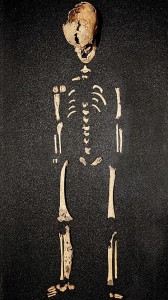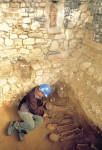 Between 1991 and 2007, Museum of London Archaeology unearthed 5,387 medieval skeletons on the grounds of what was once an Augustinian priory and hospital of St. Mary Spital in East London. Ranging in date from the 12th century to the early 16th, the bones have been a rich source of information about the lives and deaths of medieval Londoners. Twenty-five of the skeletons were ultimately found to have bone lesions characteristic of the Treponema pallidum bacterium, the spirochete whose subspecies cause pinta, yaws, endemic syphilis and venereal syphilis. This made the news a couple of years ago since seven of the skeletons dated to the 13th and 14th centuries, and one of them belonged to an 11-year-old boy with skull lesions so advanced he must have contracted the disease in utero. Out of all the diseases caused by Treponema pallidum, only venereal syphilis is transmitted from mother to unborn child, which means it was present in England long before Columbus sailed the ocean blue.
Between 1991 and 2007, Museum of London Archaeology unearthed 5,387 medieval skeletons on the grounds of what was once an Augustinian priory and hospital of St. Mary Spital in East London. Ranging in date from the 12th century to the early 16th, the bones have been a rich source of information about the lives and deaths of medieval Londoners. Twenty-five of the skeletons were ultimately found to have bone lesions characteristic of the Treponema pallidum bacterium, the spirochete whose subspecies cause pinta, yaws, endemic syphilis and venereal syphilis. This made the news a couple of years ago since seven of the skeletons dated to the 13th and 14th centuries, and one of them belonged to an 11-year-old boy with skull lesions so advanced he must have contracted the disease in utero. Out of all the diseases caused by Treponema pallidum, only venereal syphilis is transmitted from mother to unborn child, which means it was present in England long before Columbus sailed the ocean blue.
Now another major discovery has been announced: a mass burial contains 4,000 13th century victims of a cataclysmic volcanic eruption that took place the century before thousands of miles away. At first the mass grave was assumed to be a 14th century plague pit from when the Black Death decimated London or from the Great Famine earlier that century. Combining stratigraphic (layer analysis) and radiocarbon dating, Museum of London archaeologists were able to establish that in fact the pit was filled with thousands of dead in the 13th century.
Such was the size of the eruption that its sulphurous gases would have released a stratospheric aerosol veil or dry fog that blocked out sunlight, altered atmospheric circulation patterns and cooled the Earth’s surface. It caused crops to wither, bringing famine, pestilence and death. […]
Surprisingly, perhaps, the volcano’s exact location has yet to be established. Mexico, Ecuador and Indonesia are the most likely areas, according to vulcanologists, who found evidence in ice cores from the northern hemisphere and Antarctic and within a thick layer of ash from Lake Malawi sediments. The ice core sulphate concentration shows that it was up to eight times higher than Indonesia’s Krakatoa eruption of 1883, one of the most catastrophic in history.
Contemporary chroniclers support the evidence of the ice cores and the massive mid-13th century mortality. The 14th century chronicler Henry Knighton, an Augustinian cleric whose record of the Black Death in England is a valuable first person source for historians, recycled the work of earlier chroniclers like Matthew Paris in his record of the 13th century. In 1258, he wrote, massive harvest failure, famine and pestilence struck, hitting the city of London particularly hard.
The north wind prevailed for several months, and when April, May, and great part of June were over, scarcely a small rare flower or shooting germ appeared, when the hope of harvest was uncertain. Moreover, food failing, (the harvest of the previous year had failed,) innumerable multitudes of poor people died, and their bodies were found lying all about swollen from want, and livid, five or six together, in the pig-sties, in muddy streets, and on dunghills. Nor did those who had homes dare to harbour the sick and dying, for fear of infection.
About the Festival of Trinity [, seven weeks after Easter Sunday,] the pestilence was immense — insufferable; it attacked the poor particularly. In London alone 15,000 of the poor perished.
 London had an estimated population of 50,000 in 1258, so even if the numbers are exaggerated (which they probably are), we’re still talking about massive mortality, and not broad-based mortality, but the kind that strikes primarily the poor who can’t afford imported food. The rich buy it straight off the ships; the middle class sell everything they own to buy food and wind up homeless but alive. The poor wind up in charity hospital mass graves.
London had an estimated population of 50,000 in 1258, so even if the numbers are exaggerated (which they probably are), we’re still talking about massive mortality, and not broad-based mortality, but the kind that strikes primarily the poor who can’t afford imported food. The rich buy it straight off the ships; the middle class sell everything they own to buy food and wind up homeless but alive. The poor wind up in charity hospital mass graves.
A monograph on the skeletons, part one of a four part series on nearly two decades of Spitalfields archaeology, will be made available by the Museum of London for a fee on Monday.